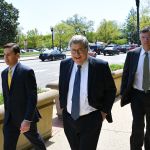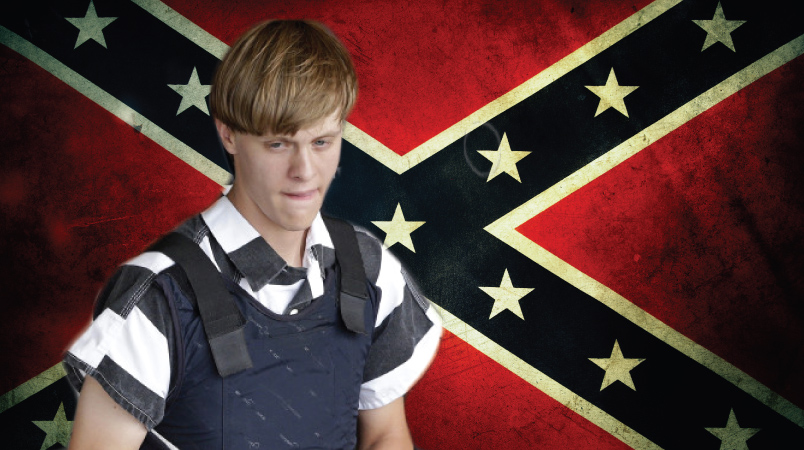A recent survey of law enforcement agencies nationwide found that police consider right-wing attacks like last week’s mass shooting at a historic black church in Charleston, South Carolina to be a greater threat than Islamic extremism.
Charles Kurzman, a professor at the University of North Carolina at Chapel Hill who helped conduct the survey, told TPM in a Friday phone interview that what we know now about the suspect in the Charleston shooting, a white, 21-year-old man named Dylann Roof, indicates that his crime fits into a larger mosaic of right-wing extremist threats that law enforcement agencies are most concerned about. That remains the case even as attacks linked to Islamic extremists, like that on the “Draw Mohammad” contest last month in Garland, Texas, dominate headlines.
The survey, conducted last year by Kurzman and David Shanzer of Duke University, in collaboration with the Police Executive Research Forum, found that 74 percent of law enforcement agencies ranked anti-government extremism among the top three terror threats they faced.
By contrast, threats linked to groups like al-Qaeda registered at that same level among only 39 percent of the 382 agencies surveyed.
In an op-ed published in The New York Times just a day before the Charleston shooting, Kurzman and Shanzer wrote that counterterrorism officials at 19 law enforcement agencies maintained in recent follow-up interviews that they were more concerned about the threat of right-wing extremism than the treat of Islamic extremism.
“Far-right extremism was not just anti-government folks, it included white supremacists and other forms of right-wing extremism as well,” Kurzman told TPM. “So it’s possible that [the Charleston shooting] is indeed part of the overall threat of right-wing extremism that we found law enforcement agencies quite concerned about.”
A chilling manifesto that surfaced Saturday and may have been penned by Roof offered further evidence that the Charleston shooting was likely motivated by white supremacy. The manifesto, published on a website called lastrhodesian.com, showed that the author was preoccupied by black people as “the biggest problem for Americans.”
“I have no choice,” the manifesto read. “I am not in the position to, alone, go into the ghetto and fight. I chose Charleston because it is most historic city in my
state, and at one time had the highest ratio of blacks to Whites in the country. We have no skinheads, no real KKK, no one doing anything but talking on the internet. Well someone has to have the bravery to take it to the real world, and I guess that has to be me.”
The website was registered in February under the name Dylann Roof and
included photos of a man who appears to be him, but it has not been
verified as belonging to the suspect.
The manifesto’s references to Charleston and the history of the black community in that city align with the crime. The suspect sat in on a Bible study Wednesday night at Emanuel AME Church in downtown Charleston for an hour before opening fire and killing nine people.
Sylvia Johnson, a cousin of a Democratic state senator who was killed in the shooting, relayed to NBC News what an eyewitness told her the killer had said before his shooting rampage.
“He just said, ‘I have to do it,’” Johnson recounted. “He said, ‘You rape our women and you’re taking over our country and you have to go.’”
Mark Pitcavage, who tracks extremism as the director of investigative research for the Anti-Defamation League, told TPM last week that a photo posted to a Facebook page that appeared to belong to Roof also indicated the suspect had white supremacist leanings.
In the photo, Roof wore a jacket featuring two patches on the right breast that Pitcavage said were white supremacist symbols. The top patch was the flag of South Africa’s Apartheid government while the bottom patch was the flag of the white-controlled colony of Rhodesia, which later became Zimbabwe.
“People don’t randomly have those symbols on a jacket,” Pitcavage told TPM. “You have to have a certain point of view, a certain world view.”
The Charleston shooting has thrust racism and gun control, among other issues, back into the spotlight over the past few days. But Kurzman stressed the need to consider the threat of ring-wing extremism in the broader context of violence in the United States. The toll that politically or ideologically motivated violence takes on the population each year amounts to less than one percent of homicides in the country, he said.
“If you just kept up with the news, you would get the misimpression that violent extremism is one of the leading threats to public safety in this country,” Kurzman told TPM. “Whereas the numbers suggest that’s not the case.”
TPM illustration by Christine Frapech. Images via AP and Shutterstock.











Everyone already knows that. Everyone, that is, except for the GOPers who demanded the withdrawal of the 2009 DHS report reaching the conclusion “white supremacist lone wolves pose the most significant domestic terrorist threat because of their low profile and autonomy.”
Someone alert the media so they can dismiss this information, continue to sow fear of the other and otherwise keep us focused away from our own brand of homegrown terrorism. It’s high time for a dialogue between the public, pols and the media (a tri-alogue?) about the role of extremism and right wing ideology in this country. We need to be talking about the effect of politicization of fear as an ideological framework, its outlets like Fox “news” and conservative shit-talkers, and the effect on fragile minds with tenuously restrained racist hate and bigotry. When I say “we” I mean we need to force liberal pols to begin to really take to task the proponents of bigotry and race politics at every opportunity.
I imagine there will be more attacks, especially when you have fear-stokers like Alex Jones, Sean Hannity, and the NRA spewing out all sorts of false and misleading information designed to prey on most people’s most deep seated fears. The other day, a conservative person posted a picture of Mr. Roof burning an American flag, with the meme saying, “Only Liberals Burn flags and hate this country.” When I pointed out to him that Mr. Roof was a conservative who had ties to white supremacists, he took the ostrich approach and simply said, “That’s not my conservatism.” To which I responded, “Well, he’s definitely not a liberal.” Logic won’t work on these people because their minds are made up. And the propaganda from the lunatic fringe is only going to make it worse. ISIS won’t have to destroy our country; the extremists within our country will do it for us…for a tax deductible donation!
The mission of the conservative movement.
Giuliani responds… “But, but, but,…Muslin Terriers!”